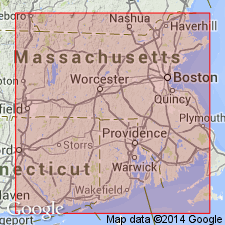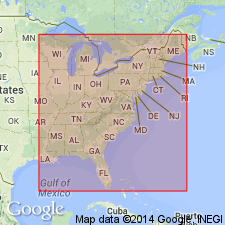
- Usage in publication:
-
- Newport Neck Formation*
- Modifications:
-
- Named
- Dominant lithology:
-
- Conglomerate
- Slate
- AAPG geologic province:
-
- New England province
Summary:
Sedimentary sequence of proximal turbidites and overlying olistoliths on Newport Neck, southeastern RI, was originally informally named Newport formation by Murray and Skehan (1979). Unit was renamed Newport Neck Formation by M.J. Webster (1986) and subdivided into four members in his Master's thesis at Boston College. The Newport Neck is here restricted to the lower three members and the uppermost is raised in rank to Fort Adams Formation. Seacoast exposures are nearly continuous on Newport Neck and Cliff Walk where the formation is 289 m thick. Consists chiefly of gray, green, and maroon graded beds 6 cm to 1 m thick. Graded beds range from fine-grained feldspathic granule conglomerate to slate. Unit is subdivided into (ascending) Brenton Point, Graves Point, and Castle Hill Members. Age is probably Late Proterozoic based on previous correlations with Price Neck Formation, which has been interpreted as a facies equivalent. However, the Price Neck may be thrust over the Newport Neck and thus may be older. [This is first published use of unit as a formal name and is therefore considered by the Geologic Names Unit to be the formal proposal.]
Source: GNU records (USGS DDS-6; Reston GNULEX).

- Usage in publication:
-
- Newport Neck Formation*
- Modifications:
-
- Overview
- AAPG geologic province:
-
- New England province
Summary:
Used as Newport Neck Formation in table 11 of report. Consists of graywacke, siltstone, phyllite, dolomite, calc-silicate rock, felsic volcanic rock, and quartzite. Age is Late Proterozoic.
Source: GNU records (USGS DDS-6; Reston GNULEX).
For more information, please contact Nancy Stamm, Geologic Names Committee Secretary.
Asterisk (*) indicates published by U.S. Geological Survey authors.
"No current usage" (†) implies that a name has been abandoned or has fallen into disuse. Former usage and, if known, replacement name given in parentheses ( ).
Slash (/) indicates name conflicts with nomenclatural guidelines (CSN, 1933; ACSN, 1961, 1970; NACSN, 1983, 2005, 2021). May be explained within brackets ([ ]).

